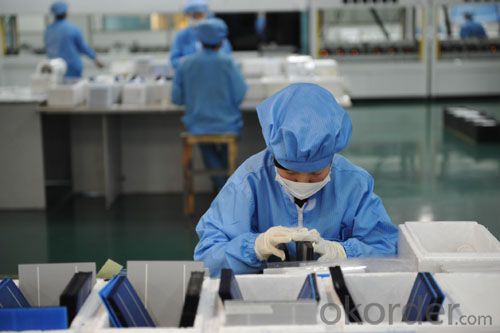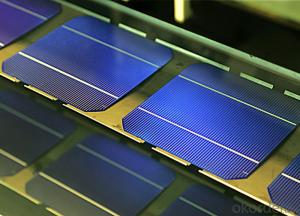Polycrystalline Solar Cells-Tire 1 Manufacturer in China-17.20%
- Loading Port:
- Shanghai
- Payment Terms:
- TT OR LC
- Min Order Qty:
- 10000 watt
- Supply Capability:
- 500000 watt/month
OKorder Service Pledge
OKorder Financial Service
You Might Also Like
Brief Introduction of Solar Cells
A solar cell, is an electrical device that converts the energy of light directly into electricity by the photovoltaic effect, which is a physical and chemical phenomenon. It is a form of photoelectric cell, defined as a device whose electrical characteristics, such as current, voltage, or resistance, vary when exposed to light. Solar cells are the building blocks of photovoltaic modules, otherwise known as solar panels.
Specifications of Polycrystalline Solar Cells
Format : 156 mm × 156 mm ± 0.5 mm
Thickness: 210 μm ±40 μm
Front (-) : 1.5mm bus bars (silver),blue anti-reflection coating (silicon nitride)
Back (+) : 2.5mm wide soldering pads (silver) back surface field (aluminium)
Efficiency (%) | Pmpp (W) | Umpp (V) | Impp (A) | Voc (V) | Isc (A) |
18.00% | 4.38 | 0.528 | 8.291 | 0.631 | 8.869 |
17.80% | 4.33 | 0.525 | 8.252 | 0.629 | 8.821 |
17.60% | 4.29 | 0.532 | 8.053 | 0.633 | 8.541 |
17.40% | 4.23 | 0.528 | 8.092 | 0.624 | 8.632 |
17.20% | 4.19 | 0.524 | 7.992 | 0.62 | 8.458 |
17.00% | 4.14 | 0.52 | 7.972 | 0.623 | 8.5 |
Advantage of Polycrystalline Solar Cells
1. Tire-1 Solar Cells’ Manufacturer Quality Guarantee. With a complete and sophisticated quality government system, our Quality Management have arrived world’s leading place. Customer can receive Tire-1 Cells Maker’s Quality Standard Products.
2. Trusted Warranty. We can supply trusted after-sales service to our customer. If our cells are found not in conformity to the specification of manufacturer, or should the inspected quantity found in shortage, or should the packing found damaged, the buyer has the right to claim to the seller. The claim, if any, should be presented to seller within 30 days after cargo's arrival date to the port, together with related inspection report and photos issued and provided by a reputable independent surveyor such as SGS.
3. World’s Leading Manufacturer Equipment. We imported the newest and leading production equipment from abroad. Advanced equipment can guarantee the stable quality of cells. Auto production line can also save labor cost which will further cut our production cost.
4. Bulk supply: With the production capacity of 500MW, we can produce large quantity every month. This can satisfy most customer requirement.
Usage of Polycrystalline Solar Cells
Solar cells are often electrically connected and encapsulated as a module. Photovoltaic modules often have a sheet of glass on the front (sun up) side, allowing light to pass while protecting the semiconductor wafers from abrasion and impact due to wind-driven debris, rain, hail, etc. Solar cells are also usually connected in series in modules, creating an additive voltage. Connecting cells in parallel will yield a higher current; our solar cells have passed IEC Certification. With high and stable quality, our cells can greatly improve the performance of Solar Modules.
Applications of Polycrystalline Solar Cells
Assemblies of photovoltaic cells are used to make solar modules which generate electrical power from sunlight, as distinguished from a "solar module" or "solar panel". A solar array generates solar power using solar energy.
Packaging & Delivery of Polycrystalline Solar Cells
Carton Box Package and Deliver by air. It should be noticed that it should be avoid of water, sunshine and moist.
Factory Picture of Solar Cells



We have organized several common questions for our clients,may help you sincerely:
1. What’s price per watt?
A: It’s depends on the quantity, delivery date and payment terms of the order. We can talk further about the detail price issue. Our products is high quality with lower price level.
2. Can you tell me the parameter of your solar cells?
We have different series of cells with different power output, both from c-si to a-si. Please take our specification sheet for your reference.
3. How do you pack your products?
We have rich experience on how to pack the panels to make sure the safety on shipment when it arrives at the destination.
4. Can you do OEM for us?
Yes, we can.
5. How long can we receive the product after purchase?
In the purchase of product within three working days, We will arrange the factory delivery as soon as possible. The perfect time of receiving is related to the state and position of customers. Commonly 7 to 10 working days can be served.
- Q:Can solar cells be used in transportation?
- Yes, solar cells can be used in transportation. Solar-powered vehicles and boats have been developed, and solar cells can be used to power various components in electric vehicles such as charging stations, auxiliary systems, and even directly powering the vehicle itself. However, the efficiency and cost of solar cells still pose challenges for widespread adoption in transportation.
- Q:Can solar cells be damaged by hail or other weather conditions?
- Yes, solar cells can be damaged by hail or other severe weather conditions. Hail can cause physical damage to the surface of solar cells, such as cracks or breakage, which can reduce their efficiency or render them completely non-functional. Additionally, extreme weather conditions like hurricanes or strong winds can also dislodge or damage solar panels, impacting their performance. Therefore, it is essential to consider the durability and resilience of solar panels when installing them in areas prone to severe weather.
- Q:What are the applications of solar cells?
- communication / communication field: solar unattended microwave relay station, optical cable maintenance station, radio / communication / paging power system; rural carrier telephone photovoltaic system, small communication machine, soldiers GPS power supply.
- Q:Can solar cells be used for powering mining operations?
- Yes, solar cells can be used for powering mining operations. Solar panels can be installed on mining sites to harness sunlight and convert it into electricity, providing a sustainable and renewable power source for various mining activities. This can help reduce reliance on fossil fuels, lower operating costs, and minimize environmental impact associated with traditional power generation methods. However, the feasibility and effectiveness of using solar cells for mining operations depend on factors such as the location of the mine, available sunlight, energy demand, and the size and efficiency of the solar array.
- Q:What is sun cells technology?
- The history of sun cell can be traced back to 1839, when the French physicist Becquerel Alexander-Edmond discovered the photovoltaic effect (effect Photovoltaic). Until 1883, the first selenium solar cell was made by the American scientist Fritts Charles.
- Q:Can solar cells be used to power remote disaster response systems?
- Yes, solar cells can indeed be used to power remote disaster response systems. Solar cells generate electricity by converting sunlight into energy, making them an ideal source of power in areas where conventional electricity infrastructure is unavailable or disrupted due to a disaster. By harnessing solar energy, remote disaster response systems can operate efficiently and sustainably, providing essential services such as communication, lighting, medical equipment, and other critical functions. Additionally, solar cells are portable, durable, and can be easily deployed in remote locations, making them a reliable and practical solution for powering disaster response efforts.
- Q:Can solar cells be used in sports arenas?
- Yes, solar cells can be used in sports arenas. They can be installed on the roofs or facades of the arenas to harness solar energy and generate electricity. This renewable energy source can help to power the stadium's lighting, scoreboards, and other electrical systems, reducing the reliance on non-renewable energy sources and lowering the carbon footprint of the facility.
- Q:What is the maximum temperature a solar cell can withstand?
- The maximum temperature a solar cell can withstand varies depending on the specific type and design of the cell. However, most solar cells can typically withstand temperatures up to around 85-90 degrees Celsius (185-194 degrees Fahrenheit) without significant degradation in performance.
- Q:Can solar cells be used in wearable technology?
- Yes, solar cells can be used in wearable technology. They can be integrated into clothing, accessories, or even directly into the design of wearable devices to harness solar energy and power them. This allows for increased portability and sustainability as wearable technology can be charged on-the-go using solar power.
- Q:Can solar cells be used to power remote oil and gas monitoring systems?
- Yes, solar cells can be used to power remote oil and gas monitoring systems. Solar cells are a reliable and sustainable source of renewable energy that can be used to generate electricity in remote locations where access to the grid is limited. By harnessing the power of the sun, solar cells can provide a continuous supply of electricity to power monitoring systems for oil and gas operations, ensuring efficient and reliable monitoring in remote areas. Additionally, solar power offers environmental benefits by reducing reliance on fossil fuels and minimizing carbon emissions.
1. Manufacturer Overview |
|
|---|---|
| Location | |
| Year Established | |
| Annual Output Value | |
| Main Markets | |
| Company Certifications | |
2. Manufacturer Certificates |
|
|---|---|
| a) Certification Name | |
| Range | |
| Reference | |
| Validity Period | |
3. Manufacturer Capability |
|
|---|---|
| a)Trade Capacity | |
| Nearest Port | |
| Export Percentage | |
| No.of Employees in Trade Department | |
| Language Spoken: | |
| b)Factory Information | |
| Factory Size: | |
| No. of Production Lines | |
| Contract Manufacturing | |
| Product Price Range | |
Send your message to us
Polycrystalline Solar Cells-Tire 1 Manufacturer in China-17.20%
- Loading Port:
- Shanghai
- Payment Terms:
- TT OR LC
- Min Order Qty:
- 10000 watt
- Supply Capability:
- 500000 watt/month
OKorder Service Pledge
OKorder Financial Service
Similar products
New products
Hot products
Hot Searches
Related keywords





























